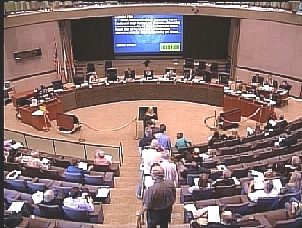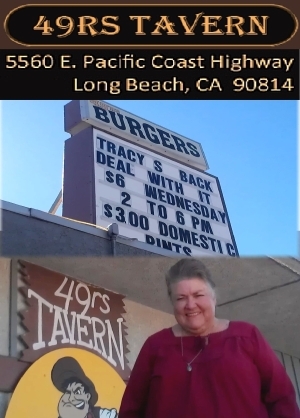
City of LB webcast screensave
[Scroll down for further.]
| (June 2, 2017, 12:45 p.m.) -- As seen LIVE on LBREPORT.com, at a June 1 Planning Commission hearing a number of prominent opponents of city staff's proposed SEASP rezoning and increased density in the PCH/2nd area of SE LB advocated a potential game-changer: they supported a development approval process they say Santa Monica and some other cities currently use that lets the City apply flexible, real-world results instead of consultant or city staff predictions on the impacts of proposed developments.
[Scroll down for further.] |
The proposal was offered by the Los Cerritos Wetlands Land Trust (through an attorney), asking city staff to explore how to apply a "baseline land use allocation policy" for the chronically polarizing SEASP land revision. The group's proposal (made verbally and in writing) drew a polite but less than warm initial staff response. City Hall's Advance Planning Officer Christopher Koontz indicated he'd only learned of it the night before, stopped short of flatly ruling it out but said it wouldn't consistent with what the City of Long Beach has done and is now doing (transcript below.) After a nearly three hour hearing, the Mayor's chosen, City Council approved Planning Commission went on to vote without dissent to recommend that the Council approve allowing up to five story buildings instead of the current three stories (red areas in map below) and with up to seven stories possible (for a hotel) on up to 20% of the area on the west side of PCH north of 2nd St. (Marina Pacific area). Seven stories could be allowed for buildings with roughly 20% of project areas [city staff text: "may be considered" for the following]: "Hotel or mixed use buildings containing hotel as a portion of their use, if it is demonstrated that significant community amenities are provided, above and beyond those that are required under the maximum height of five stories. Amenities can include plaza spaces, enhanced landscaping, public artwork, public parking, (See Section 5.7a Mixed Use Community Core height and FAR incentives.) Seven story buildings are intended to be an exception to the building massing for all structures within a project. The majority of the buildings within the Mixed-Use Community Core designations are intended to be constructed at or near the maximum base height. Building footprint of all buildings using seven stories cannot exceed 20% of the total acres in the MU-CC."
The Commission's action recommends City Council approval of the "reduced intensity alternative" ultimately recommended by city staff after public resistance to the full amount of density increases initially proposed in the draft EIR (after a "public outreach" process by consultants that some public speakers criticized as unresponsive to public objections.) City staff's agendizing memo acknowledged that traffic impacts were the "most common concern expressed by the public." It says the reduce intensity alternative "results in the least potential traffic increase between the existing PD-1 and SEASP. Through reductions in residential and particularly commercial development, the reduced intensity alternative results in impacts comparable to buildout with the existing PD-1 regulations.
Under the "reduced intensity alternative," city staff forecasts a capacity of 2,584 new dwelling units, an increased population of 4,018 persons and commercial employment of 307,071 sq. feet. The Planning Commission's voted action sends its recommendation on the SEASP rezoning to the City Council with an accompanying EIR that includes a "statement of overriding considerations" acknowledging that some environmental impacts of the SEASP rezoning, including traffic, will be significant but can't be feasibly mitigated.) Five Council incumbents, including 3rd dist. Councilwoman Suzie Price and Mayor Robert Garcia (the latter with a veto but not a vote) are seeking second terms and will face voters in April 2018.
For the second time in recent weeks, members of the public were required to speak under oath while city staffers were allowed to make representations without being sworn. That procedure was questioned on social networks after a May 16 Planning Commission hearing on the controversial Belmont Plaza Pool project, and this time the issue came up during the Planning Commission SEASP proceeding. Project opponent/taxpayer Warren Blesofsky raised the issue immediately as he came to the podium, urging the chair to make a point of order on the matter. Mr. Blesofsky said: "Chapter 2.93, 'Conduct of Hearings says that all the staff has to be sworn in before hearings, and the staff's not swearing-in so this hearing shouldn't be happening right now." LB Municipal Code section 2.93.010 -- Applicability: This Chapter applies to the conduct of all hearings, appeals or investigations held by the City Council, the Planning Commission or the Board of Examiners, Appeals and Condemnation pursuant to this Code or any other applicable law where oral evidence or testimony is received and where personal or property rights are involved. This Chapter does not apply to and is not intended to infringe upon the right of a citizen to petition his government for redress. This Chapter applies to all City personnel who testify or present evidence in a hearing. Planning Commission Chair Van Horik responded to Mr. Blesofsky: "We have a procedure that we follow every meeting and I'm going to stick to it right now." No Commission members questioned the chair's ruling or made any inquiry of Assistant City Attorney Mike Mais who was present and remained mum on the matter.
Public speaker Kerrie Aley was first to publicly urge that the city apply baseline allocation development. She said that policy could provide "a fail safe...where there is a baseline development plan. Should traffic exceed the predictions or if mitigations are not provided, development can be capped at this level." She was later followed by Attorney Michelle Black (with the firm of Chatten-Brown and Carstens) representing the Los Cerritos Wetlands Land Trust, who (in addition to presenting written testimony) stated at the public podium: We suggest incorporation of a baseline land use allocation policy...used in Santa Monica, Livermore among other cities. Such a policy would set a baseline allocation for the amount of development allowed under SEASP and provide for extra development intensity up to a certain cap for projects that provide additional community benefits. Wetlands enhancement viewing areas, sustainable building projects, sustainable energy sources, the list goes on. The extra intensity under such a policy would be awarded annually...and it would be discretionary, thereby allowing the City to evaluate how SEASP development is going. As it goes over time before deciding whether extra intensity could or should be allowed. If impacts are less than anticipated in the SEASP EIR, then extra intensity could be awarded to future projects. If impacts are greater than anticipated in the EIR, extra intensity could be withheld or there'd be time to craft additional mitigation. This approach grants the City greater flexibility and greater control while incentivizing development of better projects. A baseline land use allocation policy would satisfy CEQA's requirements to fully mitigate remaining environmental impacts and we ask that staff explore how such a policy could be implemented in SEASP. Asked by Commissioner Christoffels (following public comment) about using a "baseline land use allocation policy," City Hall's Advance Planning Officer Christopher Koontz replied: Mr. Koontz: I did get a chance to review that when I received that last night. And it's important to understand what that is. That's the equivalent of doing a development agreement on every case and negotiating a set of community benefits on every case. It's inconsistent with what we're trying to do here, the direction from City Council not just on this project but in general and the Economic Blueprint is to bring certainty and established procedures to the development process. The approach taken in Santa Monica was to lower or freeze the development potential to all sites, and then have a menu of different community benefits and then have a negotiation based on the specifics of that project and then bring that before the Planning Commission and then try to come to an agreement and then bring it to their City Council.
Ms. Alie and public speaker Ann Cantrell also cited the City's planning and development record. Ms. Aley described previous City Hall actions that over time changed the area from what had been public access waterfront to what she called a big box development. Ms. Cantrell read into the record the reasons stated by the City in seeking and obtaining a grant of $929,000 from the Strategic Growth Council (with $299,000 from City Hall's Development Services fund) to perform the SEASP zoning update and EIR. Ms. Cantrell noted that the EIR stated that its primary goal was to develop and implement plans that will reduce greenhouse gas emissions consistent with AB 32 and SB 375 and achieve the following program objectives, which were to improve air and water quality, promote public health, promote equity, increase housing affordability, promote infill and compact development, revitalize urban and community center, protect natural resources, reduce automobile usage and fuel consumption; improve infrastructure systems; promote water conservation and strengthen the economy.'" Ms. Cantrell noted that the "economy" was only one of these 12 goals...but by the time the project EIR was written, it proposed to increase height and density based by focusing on whether the development would be 'economically viable.' "In other words, the height had to be increased from the current 35 to 80 feet and the population increased so the developers could make money," Ms. Cantrell said...and urged adopting the no-project, no-development alternative. Former 3rd district Councilwoman Jan Hall objected to allowing 5-7 story buildings and noted that city staff acknowledges SEASP will result in traffic increases that can't be mitigated (thus requiring approval of a statement of "overriding consideration.") Citing shortcutting through neighborhoods, Ms. Hall said "those roads weren't made for that kind of volume, and its increasing." She added: "What we have is a dream of urban planning in an area that's already developed." She supported "tweaking" the plan to protect the area and said she and others like minded aren't NIMBYs. "This area in the city has always supported good solid development. We don't want a no growth policy; we want a smart growth policy." Belmont Shore resident Jeff Miller testified that "From the beginning, it appeared that the process for revising SEADIP was flawed. The details...being considered now are the proof this process was flawed. The proposed SEASP would not accomplish the stated aims of wetlands protection and community improvement...Travel through the area would be more difficult and time consuming, parking would be more difficult, air quality would be reduced and the views and appreciation of the wetlands, marina, trees, mountains and sky would all be degraded. The City's document, CEQA Findings of Fact page 8, says 'significant and unavoidable impact: air quality, transportation and traffic.' SEASP promises vaguely defined 'amenities' in exchange for these negative impacts, the present aesthetic attributes are already amenities. There's no public benefit to exchange these existing amenities for lesser ones. So who would benefit from increased density and increase building heights? The answer appears to be what many people suspected from the beginning of this process: the commercial property owners and developers..." Mr. Miller urged that the Commission recommend the "no project, no development" alternative to the City Council. Speaker Warren Blesofsky noted that SEASP includes a "programmatic EIR" by which the City can avoid future environmental review for 2nd and PCH projects [similar to the City's staff-supported, Council-adopted Downtown development Plan.] "They [city staff] want a programmatic EIR so that further environmental review does not have to be done, and when you cut out further environmental review, you cut out the citizenry's opportunity to comment on what's important to them. So this board has an obligation to the promises made in 1977 and in 1980 and we will fight any development in this area both on this body, the City Council and at the Coastal Commission." There was support for SEADIP...including some speakers endorsing it as initially proposed in the draft EIR (not the "reduced intensity alternative" now supported by city staff.) Public speaker Lee Vieira, who indicated he's a real estate lender in Long Beach and has been the President of the East Anaheim Street Business Association, said he supports the proposed SEASP zoning changes without reduction. Mr. Vieira cited "the lack of housing that we have to support the residents who need properties" and added "Real estate development is not available in Long Beach unless you go up [allow increased heights] because we don't have any more land" and added "There's a lot of people who don't want to see change, but we need to have change in order to develop, otherwise we wouldn't have the Port of Long Beach; we wouldn't have a downtown Long Beach; Naples would be a mud swamp and we'd all be living in tents." Roy Hansen, also a Belmont Shore resident, said "the people that would benefit are the people who are not yet here yet, with high salaries able to afford those units that want high rise living style with restaurants on the first floor...I'm prepared to deal with some additional traffic...I am not in favor of reducing the intensity of the residential development. We need that. If we had fought along those lines of reducing and preventing development in this area, a lot of the folks who came here tonight to complain wouldn't have housing. So I'm speaking for the people who are not here, that want to be here in southern California that want to be in Long Beach." Frank Elizando of Belmont Shore said, "I am not a CAVE Person, a Citizen Against Virtually Everything. I do not represent people who hate to get out. I represent the working class, the people who embrace change, the people who love to see an upgrade in this area around 2nd and PCH" and recommended approval of the draft EIR version of SEASP. Two professional engineers, who acknowledged they were retained by (one said) a "local landowner" and (the other said) a "local land developer" spoke in favor of SEASP, one of whom cautioned against the "Reduced Intensity Alternative": Brian Jones, a professional engineer with Alta Planning and Design ("overseeing our complete streets and engineering disciplines") likewise said he'd been "retained by a local land developer to review this EIR" and SEASP and testified: "The fact that SEASP has a potential to completely transform the PCH corridor to be the gem of Long Beach, and true place to better serve the ever-changing dynamic needs of the people in the community is a key component to this plan...SEASP can change the course by creating a vibrant pedestrian focused experience whether you live or recreate in this area. Thoughtful street design, increased density and mixed use of heights and subterranean parking will help transform PCH so that it can serve as a main-street like gateway with connections to the wetlands and the waterfront...With added density and private investment for the redevelopment of key sites in the area, the SEASP plan can enhance amenities, retail options and destinations within walking and biking distances. In time, local family, personal, social and recreational trips will be accomplished in something other than a personally owned vehicle. I also believe that the reduce intensity alternative may impede the bold vision of the plan and limit opportunities for better connectivity, enhanced amenities, improved quality of life and added mobility choices for area residents." Mr. Jones said it would also "reduce the financial sustainability of the resources of the city to provide services to the area such as roadway maintenance or traffic management approaches" and urged support for SEASP as described in the EIR. Jason Stack, a professional traffic engineer with STC Traffic ("an engineering firm sppecializing in the design, implementation and operation of high tech intelligent transportation systems") retained by a "local landowner to review the draft SEASP and EIR relative to traffic" testified that "emerging technologies could effectively re-shape traffic management and operations in the community..." and "allow engineers to monitor traffic throughout the city in real time and take swift action to resolve issues." Such intelligent transportation system "are proven to improve the effective capacity of roadways, reduce travel times, reduce exhaust emissions and fuel consumption and improve roadway safety." He said "the plan as drafted represents an opportunity for private investment to help fund new traffic improvements. In fact, this private investment is a critical factor fulfilling the vision of SEASP and to take advantage of emerging technologies and more quickly improve near-term traffic operations." The Commission vote was unanimous: for the "reduced intensity alternative" modified to increase allowable building heights to five stories (in the red areas on the map) with up to seven stories allowed (enabling a potential hotel use) west side of PCH at the Marina Pacifica center.
For years, developers have had to live with SEADIP's current height and development limits or seek City Council (and Coastal Commission) ad hoc approval for specific developments. Former 3rd dist. Councilman Gary DeLong made an effort to advance an overall update to SEADIP but it foundered after some criticized DeLong's-chosen advisory panel as less than transparent. In December 2011, a developer-propelled proposal to put a partial high rise/mixed use development at the 2nd/PCH Seaport Marina hotel site failed to gain Council majority approval. (Vote was 3-5, Yes: Garcia, DeLong, Gabelich; No: Lowenthal, O'Donnell, Schipske, Andrews, Neal; Johnson absent). Public issues included traffic, height, Coastal zone and wetlands impacts. The Planning Commission's recommendations/voted actions now go to the City Council...where a Council majority will decide on any zoning updates...which will also require approval by a majority of the CA Coastal Commission. SEASP's detailed proposed revisions (caveat: as of July 2016) can be viewed in full here. To view the draft Environmental Impact Report (EIR) accompanying the proposed zoning changes, scroll to the SEASP documents at this link. blog comments powered by Disqus Recommend LBREPORT.com to your Facebook friends:
Follow LBReport.com with:
Contact us: mail@LBReport.com |
   
 Hardwood Floor Specialists Call (562) 422-2800 or (714) 836-7050  |